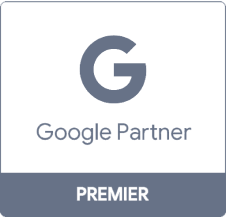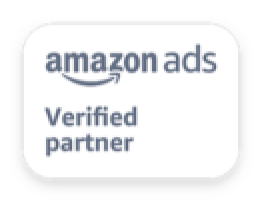What Is Earned Media? [Guide]
Earned media, also called earned content or even free media, describes content written about your business by third parties and published on channels that you don’t own, like posts on social media.
This isn’t content you pay for or own — you have to earn it.
While earned media was elusive in the pre-digital age, it’s now become something that companies of all sizes can earn. Whether it’s a tweet on social media, a post on a hobby blog, a review on Google, or a write-up by a news site, you can attract earned media to build your brand and online presence.
Keep reading to learn more about earned media, as well as some earned media examples!
If you need help building an earned media strategy and “earning” earned media, WebFX can help. With our digital marketing services, we can help your business grow its online presence and generate real results, like leads and revenue. Contact us online or call us at 888-601-5359 to learn more!
What is earned media?
Earned media describes content that, while about your company, isn’t published on channels or sites that you own, like your website or social media profiles. Since you don’t pay or own that content, you have to earn it.
5 examples of earned media
Curious about the different forms that earned media can take? Browse these earned media examples:
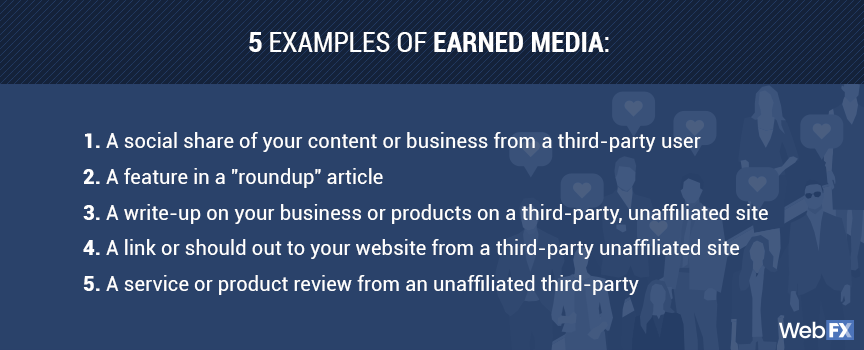
- A social share of your content or business from a third-party user
- A feature in a “roundup” article
- A write-up on your business or products on a third-party, unaffiliated site
- A link or shout out to your website from a third-party, unaffiliated site
- A service or product review from an unaffiliated third-party
When thinking about earned media examples, you want to remember the differences between earned media, paid media, and owned media. Keep reading to find out about their unique features and how they work together.
Why you shouldn’t pay for earned media
When discussing earned media, it’s common to think, “Well, couldn’t I pay for a blog post, tweet, or review?” You could, and some companies do. This approach of angling paid media as earned media, rarely works in favor of the business.
Automaker Mazda, for instance, created a blog to promote itself, with the angle that some unbiased third-party wrote and managed it. The blog voiced its full support for Mazda, which backfired once people discovered that Mazda was behind the blog.
If you try to pay for earned media, you risk your company’s brand and goodwill. Earn your press instead, whether by providing excellent customer service, interacting with social media followers, or outreaching publishers in your market.
Earned media vs. paid media vs. owned media
To understand earned media, you need to understand the other types of media: Owned and paid.
Owned Media
As you may have gathered from its name, owned media refers to the content that your company owns and retails control of. This includes all pages on your site and blog, as well as the content on your social media channels.
Paid Media
Paid media includes anything you pay to reach customers with, like advertisements or sponsored content on news sites and blogs. Essentially, any time there is a monetary transaction before you reach customers, you’re working with paid media.
Earned Media
Earned media, then, refers to content that relates to your business but isn’t published on properties you own, and you also didn’t pay for. In some cases, this occurs naturally, but in others, it’s the product of outreach and promotion.
Earned, owned, and paid media in action
While different, earned, owned, and paid media can work together. Take the following example.
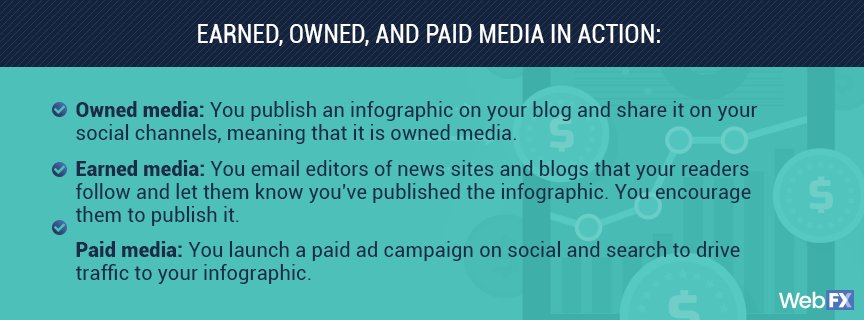
Your company creates an infographic about a popular topic within your industry and then:
- Owned media: You publish the infographic on your blog and share it on your social channels, meaning that it is owned media.
- Earned media: Then, you email editors of news sites and blogs that your readers follow and let them know that you’ve published the infographic. You encourage them to publish it on their site, and they do. This is earned media.
- Paid media: Finally, you launch a paid ad campaign on social media and search to drive traffic to your infographic. This strategy is a form of paid media because you’re paying for those clicks, views, and traffic.
For the best results from your marketing efforts, you want to use owned, earned, and paid media.
Why is earned media useful?
Although earned media can sometimes happen naturally when your business does something newsworthy, it’s more often the product of research and outreach. This means that it requires much more work than simply publishing it on your own website.
So why go to the trouble?
When it comes down to it, the biggest advantage of earned media is that consumers know that all companies post favorable content about themselves. They know that the articles and posts on your own site are designed to make your products and services sound great, and will consider everything at least slightly biased.

With earned media, on the other hand, readers see that objective editors and site owners found your content worthy of publishing or your business worth discussing. They know that the opinions are more likely to be unbiased than anything on your own site, and that the authors have no reason to falsely publish things about your brand.
In addition to reinforcing your company’s image to those who are already familiar with it, earned media can also help you reach a larger audience than content on your own site ever could.
Unless you’re a large corporation and have spent years building your online presence, it’s unlikely that you earn more than a few thousand visitors per month. And while this isn’t necessarily a bad thing, especially if those visitors are qualified and likely to convert, one article on a popular industry site could easily earn that many readers in a single day.
With earned media, you can grow brand awareness – and if the coverage is favorable, increase interest in your products and services.
Plus, most reputable sites will also include a link to your site within the content. And if you’re familiar with SEO, you know that this alone makes earned media worth your time. Link building is a difficult and time-consuming process, and links from popular sites within your industry can have a huge impact on your rankings.
We foster and form long-term partnerships so that your business has long-term results.
Over 90%
How to gain earned media for your brand
Now that you know earned media’s definition, are you ready to learn how to “earn” earned media?
Get started on your company’s earned media strategy with these five steps:
1. Make social a part of your day
Social networks like Facebook and Instagram are handy for earned media strategies.

You can use social media to connect with your target market, interact with your clients, and even engage industry insiders, like bloggers, thought leaders, and more. Communicating with your audience can make a tremendous difference in the performance of your earned media and marketing strategies.
Set aside time to check social media and interact with your followers and non-followers.
2. Publish content that’s worth sharing
Your content is one of the most critical components to your earned media strategy.
If you don’t create content that people want to share, you can expect setbacks in your approach. You’ll struggle to attract shares, links, shout-outs, and more if you publish sub-par content. Give people a reason to share your content.
Think about what motivates your audience, as well as interests them.
What creative content can you create that will get them excited and engaged? Interactive content, like quizzes, is an excellent example of content that users love. Infographics are another, offering people quick information in an eye-catching format.
3. Network with industry insiders
Outreach is another vital part of your earned media efforts.
When you reach out and network with people in your industry, like bloggers, thought leaders, and other individuals, your work becomes easier. Building a relationship with these individuals can make earning media less of a hassle because they know and respect you — as well as your content.
Remember, however, that people in your industry aren’t there to help you. Give them a reason by offering something of value too, like an A+ piece of content. If you don’t, you’ll struggle to network with these individuals as a part of your earned media strategy.
4. Become your audience’s favorite brand
Your audience can play a significant part in your earned media strategy, as well as your overall success.
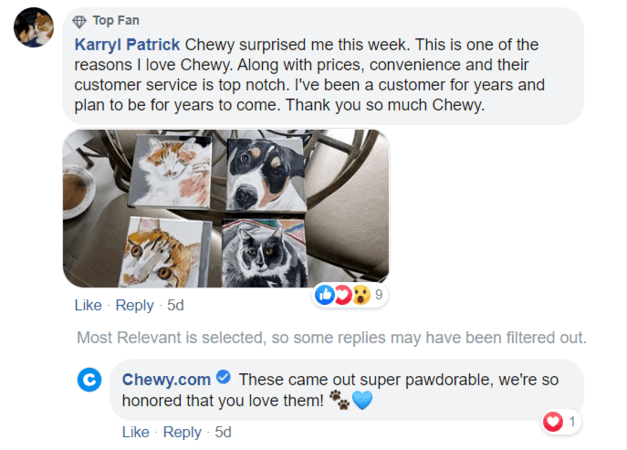
Maximize the role of your audience by becoming their favorite brand. You can move into this role by offering your clients an unparalleled experience. While this initiative may require a significant investment from your team, it will benefit your company in multiple areas, including your sales.
A few ways that you can improve your audiences’ feelings towards your brand include:
- Respond to customer questions via social media and email fast
- Interact with customers like a human versus machine
- Provide quality products and services
- Offer a streamlined customer experience, like for purchases, payment, and more
While your audience’s passion for your brand won’t change overnight, this initiative can make a long-term impact on your business and its success.
5. Prepare to fail
Earned media is one of the most challenging parts of online marketing.
That’s why your business should prepare to fail some of the time. You may not hear back from industry bloggers, for example. Or, you may launch content that gets almost zero shares from your audience. It happens.
Make the most of these failures by compiling a list of takeaways. How can your business do better next time? Or, why do you think an initiative didn’t work well? Ask questions and get insight into how you can improve.
Our digital marketing campaigns impact the metrics that improve your bottom line.
See Our Approach
$10 billion

24 million

7.14 million
Want to start using earned media for your business?
Earned media can be extremely valuable to any company’s marketing strategy, but earning it is often easier said than done. If you want to start using it to reach new customers and grow your brand, WebFX can help.
Our talented earned media team has years of experience helping our clients build relationships with editors and site owners.
Contact us today to speak with a strategist about how your company can start earning coverage on other sites to grow your brand.
Marketing Tips for Niche Industries
- Top-of-the-Line SEO Services for Health Insurance Companies
- Tourism SEO: 3 Tips for Getting Started
- Turn Online Searches into Sales with SEO for Flooring Companies
- Urgent Care SEO & SEO Services
- Why Long-Tail Keywords Are Important for Electricians
- Why SEO for Museums Matters
- Why Your Grocery Store Needs SEO
- Your Guide to Long Tail Keywords for Dentists
- Your Intro to Digital Marketing for Metal Fabricators
Additional Reading
- What Are Backlinks?
- What Are Google Penalties and What Do They Mean?
- What Are Keywords for SEO?
- What Are the Differences Among Google Yahoo and Bing
- What is Dark Search?
- What is Ecommerce SEO?
- What is Google SEO?
- What is Keyword Stemming?
- What is a Backlink Analysis?
- What Are Canonical URLs
- What Are LSI Keywords?
- What is Internal Linking?
- What is Keyword Cannibalization?
- What is a Google Algorithm?
- What is an SEO-Friendly URL?
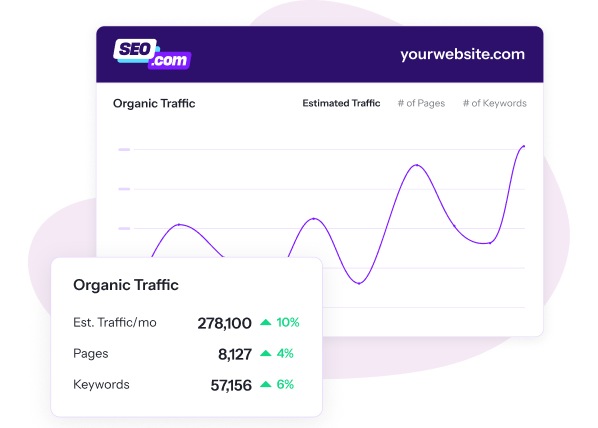
Optimize Your Website Faster with SEO.com
Effortlessly find opportunities and monitor performance with this user-friendly tool designed by the SEO experts at WebFX!
Try it for Free






